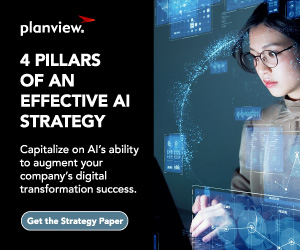
Most strategies carry with them a failure rate of 60-90%. This isn’t a revelation: Organizations have been dealing with failed strategies for decades.
However, this is 2024—the year AI must prove its value. If leaders want their AI bets to pay off, they need to transform strategy implementation from organizational weakness to core competency.
To determine how organizations can excel at strategy implementation, Planview commissioned Economist Impact (the research arm of The Economist) to develop a global study on why strategies fail. The findings revealed common challenges, pitfalls, and best practices for leaders.
One takeaway from the research is this: As important as it is for executives to shape a company’s strategy, it’s equally necessary for them to direct the course of strategy implementation—with leadership, guidance, oversight, and support.
That said, a great temptation for a leader involved in implementation is to over-index employee busyness and lose sight of outcomes.
Output myopia—the shadow state of a productivity mindset in overdrive—stifles employee engagement and the pursuit of business outcomes.
In this post, you’ll uncover why engagement matters from strategy to execution, plus four actions leaders can take to improve engagement across their organization.
Why Employee Engagement Matters to Strategy Execution
In a sense, strategy and execution are like the left and right hemispheres of the brain: Both work together to accomplish objectives. Both are necessary for humans and companies to thrive.
However, neither can function to their fullest potential unless they are connected – the brain, by the corpus callosum, and strategy and execution, by engagement.
Employee engagement can be the missing link between strategy and execution.
In fact, more than four out of five executives we surveyed acknowledged the need to improve employee engagement, suggesting it’s a widespread contributor to a failing strategy.
Disengaged employees are typically less productive and innovative than engaged employees, leaving a gap between their performance and their potential in multiple areas.
Conversely, engaged employees:
- demonstrate strong self-motivation and productivity, even in remote work settings,
- support a company’s competitiveness by improving their own efficiency, contributing to innovation, and supplying excellent customer service, and
- are deeply connected to the organization’s purpose and values, leading to longer-term retention.
The higher a leader’s role in an organization, the less likely they are to have personal connections with hundreds or thousands of employees to support or gauge their engagement—that type of visibility doesn’t scale in the same way that communicating a company vision does.
However, by acting on the recommendations below, leaders – especially executives – can set expectations, direct policy creation, and ultimately build a culture that cascades across an organization, inducing higher engagement in achieving business outcomes.
Four Actions That Support Employee Engagement
Make strategy social
Silos and strategies don’t mix, yet it’s what most companies do. Over 80% of executives acknowledged the need to enhance their companies’ internal communication and cross-functional collaboration during strategy creation.
When leaders adopt a social approach to strategy, they avoid planning in ivory towers or basing their plans largely on financial returns. Instead, they crowdsource customer needs and operational challenges to inform their strategy. This approach benefits organizations at all levels.
- Leaders stay grounded in the reality of their organization.
- Middle managers get a voice.
- Team members see that strategy is created by exchanging recent, relevant knowledge.
Early involvement and alignment among key stakeholders lead to stronger buy-in and ownership in implementation, which in turn leads to higher employee engagement.
Build in two-way communication
A natural extension of making strategy social is fostering two-way communication. It’s another element that companies tend to overlook: Only about half of executives (48%) indicate that they prioritize two-way communication when relaying strategy to employees.
Rita McGrath, a strategy professor at Columbia Business School and bestselling author, encourages leaders to be “in constant touch with the edges of the organization, establishing an ongoing system rather than a one-time interaction.”
A regular cadence of updates during implementation maintains the standard set during strategy creation: Knowledge is most powerful when shared.
In a two-way exchange of knowledge, leaders and employees alike can more fully understand risks, barriers, and changes in the market and with customers – and feel connected to them. The emotional connection fuels engagement.
Adopt a single source of truth
Along the continuum of strategy to execution, software enables everything from running scenario planning in real time and creating OKRs to chatting with AI copilots and managing the day-to-day tasks of implementation.
Software connects people to each other and their work. But here’s the catch: For the highest return, the software must be connected, too.
Disconnected or fragmented systems cause multiple issues. One is the lack of visibility created by siloed data. Data silos leave leaders without the information they need to make informed decisions and teams unsure about the direction they need to take or if the information they have is accurate.
On the other hand, a single source of truth connects people, their tools, and their work with real-time information, providing clarity and kindling higher engagement.
Acknowledge failure as a stepping stone
Culture plays a more significant role in winning strategies than many companies give it credit for. In this context, one element often stands above the rest: how a company views failure.
LEGO embraced failure to avoid bankruptcy. Pixar uses it for boundless creativity. Amazon leverages failure because they know for every Fire phone, there’s AWS and the Kindle.
Whether culture always falls upstream or downstream of policies is up for debate. However, research shows that structures like performance management, rewards systems, and skills development initiatives shape how employees view accountability, whether they share risks or issues openly, and their commitment to an organization.
Ultimately, cultures that acknowledge failure as a stepping stone tend to have higher levels of engagement than those that don’t.
People are Required for AI’s Success
Capitalizing on an AI strategy is like any other strategy: Each is just a vision until the work gets done.
However, something better than mere output is when the people of your company—united by intentional actions from leadership—get the right work done at the right time.
It’s a hallmark trait of a business focused on outcomes, and highly engaged employees are necessary to achieve them.
Where to go next:
- Uncover five recommendations for turning strategy into reality with the full report from Economist Impact, commissioned by Planview
- Address the disconnects in your organization that waste millions of dollars each year
- Learn how Planview is using AI to drive transformation and see the latest in our AI capabilities




